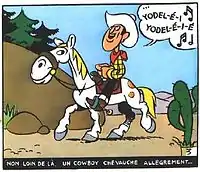Jolly Jumper
Jolly Jumper is a horse character in the Franco-Belgian comics series Lucky Luke, created by Belgian artist Morris. Described as "the smartest horse in the world" and able to perform tasks such as chess-playing and tightrope walking, Jolly Jumper accompanies his master in their travels across the Wild West, and delivers frequent quips. In the Greek version of the series, Jolly Jumper is female and is called "Dolly".

| Jolly Jumper | |
|---|---|
| Publication information | |
| First appearance | Arizona 1880 (1946) |
| Created by | Morris |
| In-story information | |
| Species | horse |
Publication history
Jolly Jumper first appeared along with Lucky Luke in the story Arizona 1880, published in the Almanach issue of the Franco-Belgian comics magazine Spirou on December 7, 1946.[1] In his earlier appearances, he was more like a real horse, which started to change after René Goscinny became the series' main writer.
Character

Jolly Jumper is a white horse with a brownish spot on his left side and a blond mane. He dislikes dogs, as seen in Sur la piste des Daltons where he continuously directs offensive comments towards the unintelligent prison-dog Rantanplan. Extraordinarily apt and anthropomorphic, the character is very resourceful in adventure and crises, and mischievous as in Le Bandit Manchot, when he beats Lucky Luke in a dice game, winning the role-reversal to be carried on Lucky Luke's back. As an intelligent, yet silent character, Jolly often functions as an audience substitute, and will comment on the plot with exasperation or sarcasm. Jolly Jumper is shown to voice his comments aloud, but as neither Lucky Luke or any other human ever replies to them, these comments are understood to be normal horse neighing instead of understandable speech.
Jolly Jumper is not as eager to jump into new adventures as his master is, but will follow him wherever he goes, and it has been shown in the prequel comics that the two grew up together.
Sources
- Lucky Luke publications in Spirou and Pilote BDoubliées (in French)
- Footnotes
- BDoubliées. "Spirou année 1946" (in French).
External links
- Lucky Luke official site (in French)